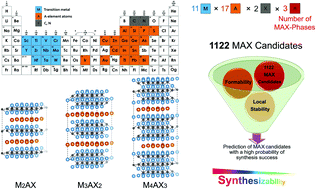High-throughput computational discovery of ternary-layered MAX phases and prediction of their exfoliation for formation of 2D MXenes†
Abstract
The rush to synthesize novel two-dimensional (2D) materials has excited the research community studying ternary-layered carbide and nitride compounds, known as MAX phases, for the past two decades in the quest to develop new 2D material precursors. The objective of this study is to expand the family of MAX phases and to investigate their feasible exfoliation to generate 2D systems. To expand the family of MAX phases, we conduct systematic and fundamental research using elemental information and data from high-throughput density functional theory calculations performed on 1122 MAX candidates. Our results suggest that 466 MAX compounds can be synthesized, among which 136 MAX phases can be exfoliated to produce 26 MXenes. We investigate the transition metal or A elements that could be suitable for the formation of novel MAX phase carbides or nitrides and determine promising MAX phases that can be exfoliated to form 2D systems.



 Please wait while we load your content...
Please wait while we load your content...